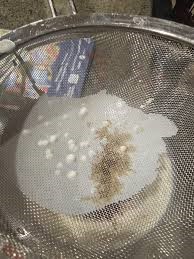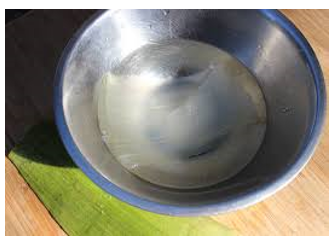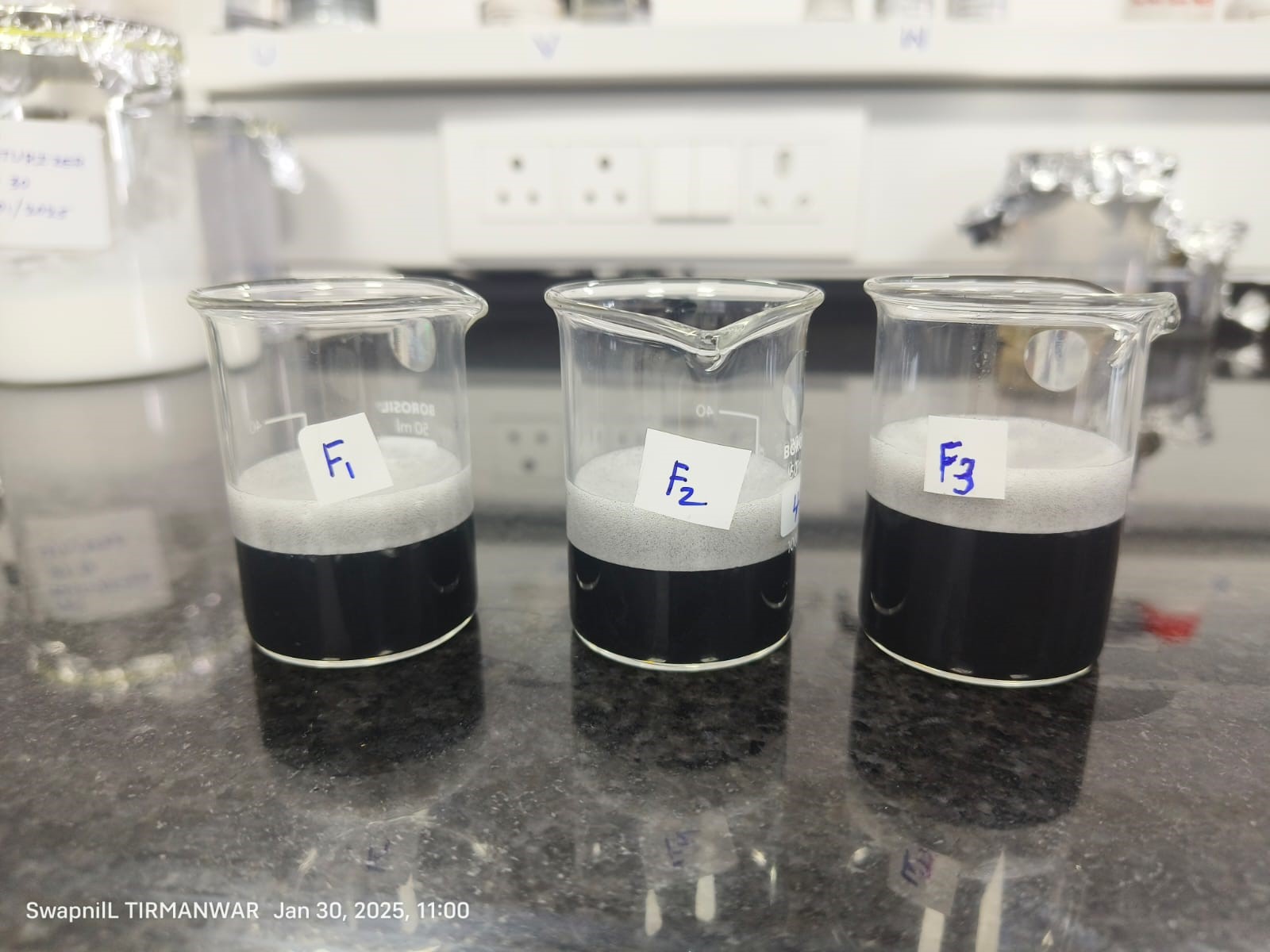Abstract
Cosmetics designed for skin care serve multiple purposes, including cleansing, exfoliating, protecting, and replenishing the skin. This is achieved through various products such as cleansers, toners, serums, moisturizers, and balms. On the other hand, cosmetics used for general personal care, particularly for more extreme makeup applications in performances, fashion shows, or for those in costume, can dramatically alter the appearance of a person’s face to resemble someone or something entirely different. A face wash is a specific facial care product that helps remove makeup, dead skin cells, oil, dirt, and other pollutants from the skin of the face. Incorporating coconut husk charcoal into a face wash enhances its effectiveness, helping unclog pores and preventing skin issues like acne. A face wash is typically used as part of a skincare routine alongside a toner and moisturizer. It is designed to cleanse the face without causing dryness and is also commonly called a “cleanser.”
Keywords
Cosmetics, skincare, charcoal, face wash.
Introduction
A face wash is a skincare product designed to remove makeup, dead skin cells, oil, dirt, and other pollutants from the skin on your face. This process helps unclog pores and prevent skin conditions such as acne. A face wash can be used as part of a skincare regimen, typically in conjunction with a toner and moisturizer. Face washes, also known as cleansers, effectively cleanse the skin without causing dryness. They are suitable for all skin types and are particularly beneficial for removing dirt and oil while providing moisture to dry skin. Both face washes and cleansers help eliminate impurities from your face, including excess oil, makeup, and grime. While a face wash can remove oil-soluble impurities, it may not be 100?fective on its own. Facial skin is delicate, and using ordinary soaps can lead to moisture loss. A face wash serves as a mild cleanser that keeps the skin clean, smooth, and fresh while maintaining moisture in the outer layer, without harsh effects. This helps the skin look youthful and energetic. The purpose of a face wash includes cleansing, providing anti-wrinkle effects, offering anti-acne properties, moisturizing the skin, and promoting an even skin tone. Skin whitening agents are believed to influence melanin production and metabolism by inhibiting its production in melanocytes. Ingredients such as propanediol, Evodia rutaecarpa fruit extract, arbutin, kojic acid, and vitamin C and its derivatives are commonly used in whitening cosmetics due to their low toxicity to melanocytes. [1,2,3,4,5,6]
Advantages of facewash [1,2,3,4,5,6]
- It helps to remove dead skin cells and helps new skin cells replace old ones
- It helps to keep skin fresh and healthy.
- It makes the skin to look radiant
- The mixture of dead skin cells and excessive oil clogs pores, which can lead to acne white whiteheads, blackheads, and a total weary appearance.
- Exfoliating the pores regularly avoids all the above skin problems.
- Removing dead skin cells means your skin will develop wrinkles at a slower pace.
- Keep the skin hydrated, soft, supple, and youthful-looking
- Stimulate blood circulation, boosting blood flow to your face for glowing skin
- Make the skin younger and help to fight any signs of aging
- Help other skin care products penetrate properly into the skin
Uses of facewash [1,2,3,4,5,6]
- Remove all traces of makeup every day.
- For cleansing the skin.
- Anti-aging.
- Bath and renewal keep the skin clean and shiny.
- Stimulates the generation of the skin cells and their renewal.
- Help plug the pores clear.
Properties of facewash [1,2,3,4,5,6]
- The exfoliation accelerates blood circulation and promotes skin regeneration and rejuvenation.
- Facial pores and Oily skin are caused by over secretion of sebum by sebaceous glands which clogs the makes the skin oilier.
- Oily skin requires cleansers with herbs and botanicals which will clean the pores and reduce oil build-up. These exfoliating cleansers contain anti-inflammatory agents and antioxidants that improve and nourish the damaged skin.
- Known for its beneficial properties, herbal face wash is used to treat acne and pimples.
- Containing rich plant-based ingredients like neem, herbal face wash removes excess oil without removing nutrients from the skin.
- It should be stable and should have a good appearance.
- It should soften on application to the skin.
- It should spread easily without dragging.
- During application it should not have an oily or greasy feel.
- After evaporation of water the cream residue should not become viscous.
- Its physical action should be that of flushing on the skin and pore opening rather than absorption.
- A thin emollient film should remain on the skin after its use [1,2,3,4,5,6]
Table 1. Composition Of Face wash
|
Ingredients
|
Examples
|
|
Emulsifying agent
|
Stearic acid, Sodium phosphate, Sodium stearoyl lactylate, Lecithin, Distilled monoglycerides (DMG)
|
|
Emollient
|
Liquid paraffin (light), Sorbitol, Glycerin, Mineral oil, Coconut oil, Hyaluronic acid, Propylene glycol, Beeswax, Almond oil
|
|
Preservatives
|
Methyl paraben, Propyl paraben, Benzyl alcohol, Phenoxyethanol, potassium sorbate, Formaldehyde, Benzoic acid
|
|
Humectant
|
Propylene glycol, Glycerin, Panthenol, Aloe vera, Sorbitol, Hyaluronic acid
|
|
Emulsifier
|
Lecithin, Glyceryl stearate, Cetearyl alcohol, Potassium hydroxide, Polysorbates
|
|
Conditioning agent
|
Sodium lauryl sulfate, Jojoba oil, Argan oil, Coconut oil,
|
|
Surfactants
|
Sodium lauroyl sulfate, Behentrimonium chloride, Chitosan, Cetrimonium chloride
|
|
Vehicle
|
Water
|
|
Skin whitening agent
|
Kojic acid, Arbutin, Azelaic acid, Ascorbic acid, Charcoal, Hydroquinone, Gentisic acid, Licorice, Retinoids, Niacinamide, mequinol, Soy, Corticosteroids
|
|
Perfume (Fragrance)
|
Citrus, lavender, eucalyptus, tea tree, floral oils, Synthetic musks, Linalool, geraniol, limonene, citronellol, and citral.
The fragrance of flowers like jasmine, rose, or lavender, while a fruity fragrance will have notes of fruit like peach, pear, or watermelon.
|
MATERIAL AND METHODOLOGY
- Water
The clear liquid that has no color, taste, or smell, that falls from clouds as rain, that forms streams, lakes, and seas, and that is used for drinking, washing, etc.
Water is polar, Water is an excellent solvent, Water has high heat capacity, Water has high heat of vaporization, Water has cohesive and adhesive properties, and Water is less dense as a solid than as a liquid. [2,5,8]
- Betaine / Trimethylglycine (TMG)
Betaine, also known as betaine anhydrous or trimethylglycine (TMG), is a substance naturally produced in the body. It plays a crucial role in liver function, cellular reproduction, and the synthesis of carnitine. Additionally, betaine assists in the metabolism of an amino acid called homocysteine. It is used to treat conditions related to a deficiency or defect in specific enzymes that result in elevated levels of homocysteine in the blood and urine. This treatment helps remove excess homocysteine from the body and is available only by prescription from a doctor. Betaine acts as a methyl group donor and is involved in the normal metabolic cycle of methionine. It is a naturally occurring derivative of choline, commonly obtained through diet, and helps regulate cellular hydration and maintain cell function. [2,5,8]

Fig. 1 Betaine
Xanthan Gum
Xanthan gum is a natural, non-toxic, and non-irritating thickener commonly used in food and cosmetics. It is a high-molecular-weight polysaccharide derived from the microorganism Xanthomonas campestris or hydrolyzed starch. Xanthan gum is soluble in both hot and cold water, forming a gel-like solution. It serves as a stabilizer and viscosity modifier in water-based systems and is also used in cosmetics to stabilize emulsions.[9]

Fig. 2 Xanthan gum
Sodium Lauryl Sulfate
Sodium lauryl sulfate (SLS) is a synthetic surfactant that is used in many products, including cosmetics, soaps, and cleaning products. It is also known as sodium dodecyl sulfate.
Uses
- Cleaning products: SLS is used in cleaning products like floor cleaners, engine degreasers, and car wash products.
- Personal care products: SLS is used in personal care products like soaps, shampoos, toothpaste, and shaving creams.
Food additives: SLS is used as a thickener or emulsifier in some dried egg products, marshmallow products, and dry beverage bases. [2,5,8]
- Decyl Glucoside
Decyl glucoside is a mild non-ionic surfactant used in cosmetic formularies, including baby shampoo and in products for individuals with sensitive skin. Many natural personal care companies use this cleanser because it is plant-derived, biodegradable, and gentle for all hair types. As derived from all-natural sources, Decyl Glucoside is non-toxic and very skin-friendly. Its gentle action on the skin makes it an ideal ingredient to be used on sensitive skin. It does not result in any rashes or irritation on the skin. [2,5,8]

Fig. 3 Decyl Glucoside
Glycerin
Glycerin is a type of carbohydrate known as a sugar alcohol or a polyol. This odorless liquid has a sweet taste and a syrupy consistency. While glycerin occurs naturally in plants through the fermentation of sugars, most of the glycerin nowadays is produced from the hydrolysis of fats and oils. Glycerin is a humectant, a type of moisturizing agent that pulls water into the outer layer of your skin from deeper levels of your skin and the air. In skin care products, glycerin is commonly used with occlusives, another type of moisturizing agent, to trap the moisture it draws into the skin. [2,5,8]
- Niacinamide / Vitamin B3
Niacinamide, also called nicotinamide, is a form of vitamin B3. It's found in many foods including meat, fish, milk, eggs, green vegetables, and cereals. Niacinamide is required to function fats and sugars in the body and maintain healthy cells. Niacin helps improve circulation, and it has been shown to suppress inflammation. All the B vitamins are water-soluble, meaning that the body does not store them. You can meet all of your body's needs for B3 through diet. It is rare for anyone in the developed world to have a B3 deficiency.
Niacin Benefits:
Scientists found that pellagra, a dangerous skin ailment, may occur in persons who were niacin deficient during the beginning of the 20th century. This discovery of the connection between B vitamins and health has made pellagra uncommon and made niacin an FDA-approved treatment. Numerous health benefits associated with niacin consumption have been asserted by academics over the years.
- Helps to maintain skincare
Including niacinamide in your skincare routine can help your skin appear softer, smoother, and more vibrant. Although research on this subject is still in progress, niacinamide may also help balance the oil production in your skin. This makes it a potentially beneficial component for those with oily skin and congested pores.
- Niacin for high cholesterol
Research indicates that niacin can reduce triglycerides and increase levels of healthy HDL cholesterol as a cholesterol therapy. Additionally, niacin somewhat reduces harmful LDL cholesterol. For cholesterol control, it is occasionally used in conjunction with statins like simvastatin (Flolipid, Zocor), rosuvastatin (Crestor, Ezallor), pravastatin (Pravachol), fluvastatin (Lescol), and atorvastatin (Lipitor).
However, only relatively high dosages of niacin are useful as a cholesterol therapy. Risks associated with these dosages include glucose intolerance, gastrointestinal issues, and liver damage. Most recently, scientists discovered a connection between heart disease and too much niacin. Therefore, avoid using over-the-counter niacin supplements for yourself. Consult your healthcare provider instead; if advised, they can recommend FDA-approved niacin dosages.
- Niacin for blood pressure
Recent research has highlighted the positive effects of niacin on cholesterol levels, and numerous studies have investigated its potential to reduce high blood pressure. Until recently, the relationship between niacin intake and the risk of high blood pressure was unclear. However, a 2021 study conducted on Chinese adults discovered a notable connection: as dietary niacin intake increased, blood pressure levels decreased among individuals with newly diagnosed hypertension.
- Sodium Benzoate
Sodium benzoate is a white crystalline powder that's used as a food preservative and pickling agent. [2,5,8]
It's also known as benzoate of soda. It is mainly used for:
- Preserving acidic foods like fruit juices, jams, pickles, and canned vegetables
- Preserving soft drinks, sauces, and margarines
- As a fuel in fireworks
- Coconut Shell Charcoal Powder
The scientific name for the coconut is Cocos nucifera. The word cocos is thought to come from Spanish and means "monkey-faced" or "eerie-faced". Nucifera is a Latin word that means "nut-bearing plant". Coconut is recognized as one of the most beneficial natural nutrients for hair. It promotes healthy growth and adds a glossy sheen. One of its key advantages is its ability to reduce protein loss, which can lead to undesirable hair characteristics and overall compromised health. In the Indian subcontinent, coconut oil is commonly used in daily hair care routines, often applied after bathing or showering. As an exceptional conditioner, coconut oil helps repair damaged hair and provides essential proteins needed for nourishing and revitalizing distressed strands. Research indicates that coconut oil offers superior protection against hair damage caused by hygral fatigue. Regularly massaging the scalp with coconut oil not only helps prevent dandruff but also alleviates chronic dryness of the scalp. Additionally, it effectively keeps both the hair and scalp free from lice and their eggs. Coconut oil is widely used as a hair care oil and is a key ingredient in many products, including conditioners and dandruff relief creams, primarily for topical application. We are specifically investigating the use of coconut shells to improve formulations for enhanced suitability in hair care.[9]
Kingdom : Plantae
Division : Tracheophytes
Subdivision : Angiosperms
Order : Arecales
Family : Arecaceae
Genus : Cocos
Species : nucifera L.
- Disodium EDTA
A chemical that binds certain metal ions, such as calcium, magnesium, lead, and iron. It is used in medicine to prevent blood samples from clotting and to remove calcium and lead from the body. It is also used to keep bacteria from forming a biofilm (a thin layer stuck to a surface). It is a type of chelating agent. It's a popular food additive, used as a preservative and flavoring agent. Calcium disodium EDTA works as a chelating agent. This means it binds to metals and prevents them from participating in chemical reactions that might cause discoloration or flavor loss. [2,5,8]

Fig. 5 Disodium EDTA
- Aloe Vera Gel
The use of the aloe vera plant dates back thousands of years, with historical records reaching as far back as 1750 BC. With over 450 species, aloe vera is a succulent plant that thrives in hot, arid climates worldwide. It is well-known for its therapeutic properties and has been used to treat various skin issues, including wounds, acne, and burns. In addition to its topical applications, aloe vera is also found in dietary supplements and beverages, and it is believed to offer benefits for conditions such as inflammatory bowel disease, diabetes, and hepatitis. However, scientific research on its effects on hair is limited. While studies on its overall benefits have yielded mixed results, this could be due to the plant's wide range of properties and active components. The diverse effects of aloe vera may result from the interaction between its chemical constituents and active ingredients.[9]
Kingdom : Plantae
Division : Tracheophytes
Subdivision : Angiosperms
Clade : Monocots
Order : Asparagales
Family : Asphodelaceae
Genus : Aloe
Species: barbadensis L.

Fig. 6 Aloe Vera Gel
Vitamin E
Vitamin E is well-known as a powerful fat-soluble antioxidant. Its primary function is to prevent the activity of pro-oxidant agents that are produced by reactive oxygen species (ROS). It effectively neutralizes free radicals that can arise from various internal and external factors, including ultraviolet (UV) radiation, medications, and environmental pollutants, thereby protecting against their harmful effects. The antioxidant ability of Vitamin E is largely due to its role in inhibiting lipid peroxidation in unsaturated fatty acids. It integrates into cell membranes, effectively reducing lipid peroxidation. Specifically, the antioxidative properties of alpha-tocopherol (the most active form of Vitamin E) come from its ability to react primarily with peroxyl radicals and singlet oxygen, both of which contribute to lipid peroxidation. This scavenging process produces a stable, low-energy compound known as tocopherol, which does not react further with free radicals. Alpha-tocopherol is particularly effective at scavenging peroxyl radicals from lipid membranes, including cell membranes and low-density lipoproteins (LDL). Traditionally, alpha-tocopherol, either in its pure form or as derivatives, is used in dermatology, often applied independently. However, for optimal results, it needs to be converted into its purified form within the skin. Topical applications of Vitamin E are designed to treat conditions such as melasma, protect against ultraviolet radiation, and address aging-related skin damage. Additionally, combining Vitamin E with other antioxidants can enhance its effectiveness on the skin. [2,5,8]

Fig. 7 Vitamin E
Procedure:
- Begin by adding aqua (water), disodium EDTA, and glycerin into a mixing beaker. Mix well for 5-10 minutes at a speed of 300-400 rpm.
- Next, add sodium lauroyl sulfate, decyl glucoside, and betaine to the mixture.
- Continue mixing all the ingredients for another 5-10 minutes at a speed of 50-90 rpm until no particles remain in the mixture.
- Then, add aloe vera extract, vitamin E, and coconut shell charcoal powder. Mix all these ingredients for 5-10 minutes at a speed of 50-90 rpm until no particles are present.
- Ensure that enough foam is produced during the mixing process.
- Adjust the texture or viscosity of the formulation by incorporating xanthan gum as needed.
- Finally, add sodium benzoate as a preservative and your chosen fragrance.
- Adjust the pH of the formulation to around 5.5 using a NaOH solution.[1,2,3,10,11,12,]
Table 2. Formulation of coconut husk charcoal face wash
|
Ingredients
|
Function
|
Quantity (%)
|
|
Water
|
Solvent
|
51
|
|
Betaine/ trimethylglycine (TMG)
|
Surfactant
|
25
|
|
Xanthan gum
|
Thickener
|
8
|
|
Sodium lauroyl sulfate
|
Surfactant
|
9
|
|
Decyl glucoside
|
Surfactant
|
3
|
|
Glycerin
|
Humectant
|
2
|
|
Niacinamide
(vitamin B3)
|
Smoothing, sebum control
|
0.5
|
|
Sodium benzoate
|
Preservative
|
0.5
|
|
Coconut shell charcoal powder
|
Removing impurities and deep cleansing
|
0.25
|
|
Disodium EDTA
|
Chelating agent
|
0.2
|
|
Sodium hydroxide
|
To adjust the ph
|
0.2
|
|
Aloe barbadensis leaf (aloe vera) extract
|
Moisturising
|
0.1
|
|
Vitamin e
|
Anti-oxidant
|
0.1
|
|
Fragrance
|
Perfuming agent
|
0.15
|
Table 3. Different Formulations of Coconut Husk Charcoal Face Wash
|
Ingredients
|
F1 (%)
|
F2 (%)
|
F3 (%)
|
|
Water
|
52.5
|
50.5
|
51
|
|
Betaine/ trimethylglycine (TMG)
|
25
|
25
|
25
|
|
Xanthan gum
|
12
|
5
|
8
|
|
Sodium lauroyl sulfate
|
5
|
13
|
9
|
|
Decyl glucoside
|
3
|
3
|
3
|
|
Glycerin
|
2
|
2
|
2
|
|
Niacinamide (vitamin b3)
|
0.5
|
0.5
|
0.5
|
|
Sodium benzoate
|
0.5
|
0.5
|
0.5
|
|
Coconut shell charcoal powder
|
0.1
|
0.2
|
0.25
|
|
Disodium EDTA
|
0.2
|
0.2
|
0.2
|
|
Sodium hydroxide
|
0.2
|
0.2
|
0.2
|
|
Aloe barbadensis leaf (aloe vera) extract
|
0.1
|
0.1
|
0.1
|
|
Vitamin E
|
0.1
|
0.1
|
0.1
|
|
Fragrance
|
0.15
|
0.15
|
0.15
|
RESULTS:
All the 3 formulations were evaluated for their Organoleptic Properties (appearance, color, and odor) and Physicochemical properties, and the results are mentioned in the given table.
Table 4. Organoleptic evaluation of Formulations
|
Organoleptic parameters
|
F1
|
F2
|
F3
|
|
Color
|
Greyish black
|
Greyish black
|
Greyish black
|
|
Odor
|
pleasant fragrance
|
pleasant fragrance
|
pleasant fragrance
|
|
Texture
|
Smooth, slippery
|
Smooth, slippery
|
Smooth, slippery
|
|
State
|
Liquid
|
Liquid
|
Liquid
|
|
Consistency
|
Liquid
|
Liquid
|
Liquid
|
|
Greasiness
|
No
|
No
|
No
|
Table 5. Physicochemical evaluation of Formulations
|
Physicochemical parameters
|
F1
|
F2
|
F3
|
|
Washability
|
Good
|
Good
|
Good
|
|
Homogeneity
|
No aggregate
|
No aggregate
|
No aggregate
|
|
pH
|
5.63
|
5.56
|
5.51
|
|
Grittiness
|
No
|
No
|
No
|
|
Extrudability
|
Good
|
Good
|
Good
|

Fig. 7 Foaming and washability testing of charcoal face wash
Skin irritability test
A small amount of face wash was applied to the skin and left for a few minutes, with no signs of redness, edema, inflammation, or irritation observed during the studies. The formulations are safe to use.
Table 5. Skin irritability te
|
Formulations
|
Irritability test
|
|
1st hour
|
3 hour
|
6 hour
|
|
F1
|
Nill
|
Nill
|
Nill
|
|
F2
|
Nill
|
Nill
|
Nill
|
|
F3
|
Nill
|
Nill
|
Nill
|

Fig. 8 Coconut husk charcoal face wash
CONCLUSION:
The face wash was formulated to be suitable for all skin types, with a mild composition. The activated charcoal in the formula effectively clears pores, removes dirt, and nurtures the skin, providing a refreshing sensation after each use, even in summer. It was designed for daily application, and various tests confirmed that its pH level is appropriate for a facial product. The cleaning efficacy of the face wash was also evaluated to ensure its effectiveness. This study aimed to develop a liquid-based face wash suitable for daily use by people of all ages, aiding in the maintenance and nourishment of the skin. The findings indicated that the liquid-based face wash (F3), which contains 2.5 grams of charcoal, excelled in terms of appearance, fragrance, cleansing ability, spreadability, and foaming properties. Importantly, it did not cause any harshness or irritation to the skin. This face wash is safe for application and has proven to be very effective.
REFERENCES
-
-
-
- Jaseer J J , Meera Ajay, Muhammed Jasmal, Nivin George, Vaishna V V , Remya S B. Formulation and Evaluation of Liquid Based Face Wash, International Journal of Pharmaceutical Research and Applications Volume 7, Issue 2 Mar-Apr 2022, pp: 1533-154
- Sharma P. P.; Cosmetic Formulation, Manufacturing & Quality Control; Vandan Publication Pvt Ltd. Delhi; 4th edition; 319.
- Wilkinson J. B., Moore R. J.; Harry? cosmetology; Longman Singapore Publishers Pvt. Ltd.; 7th edition; 494.C
- R Phate Human Anatomy & Physiology; „The Skin?; Career Publication; First Edition, 2001; 241- 246.
- Wilkison J. B., Moore R J, Harry Cosmetology; Sunscreen Lotion; Longman Singapore Publishers, 7 edition, 556-567
- Syed K. H. Gulrez, Saphwan Al-Assaf and Glyn O Phillips, A research article on Hydrogels: Methods of Preparation, Characterisation and Applications, 2011; 124–125, 126-141.
- Gillbro J. M. and M. J. Olsson, A research article on: The melanogenesis and mechanisms of skin-lightening agents – existing and new approaches, 2010; 210- 211, 211-212, 212.
- Mohammed Haneefa K.P, research article on: Formulation and Evaluation of Herbal Gel of Basella alba for wound healing activity, Journal of Pharmaceutical Science and research, 2012; 4(1): 1642-1648.
- Wealth of India, 1998. A Dictionary of Indian Raw Materials and Industrial Products and Raw Materials, vol. X. Publication and Information Directorate, CSIR, New Delhi.
- Baksh Abrar, Shaikh Anis, Bhargava Tanu, Sameer Singh, A Research Article On: Formulation and In-Vitro Evaluation of Nsaid?s Gel, International journal of current pharmaceutical research, 2012; 4(3): 56-58.
- Wanjari N., Waghmare J. A research article on: latest trend of cosmetics cosmaceuticals International Journal of pharma research & review, May 2015; 4(5): 45-51.
- More B. H., Sakharwade S. N., Sakarkar D. M., A research article on: Formulation and evaluation of herbal gel contains the flower extract of Butea monospermaamerican journal of pharm tech research, 2000;2(5): 651-658
- Jennifer C. Stephie C.M., Abhishri S.B. and Shalini B. U, A research article on: skin whitening property of plant extracts, International Journal of pharma and Bio Sciences, 2012 Oct; 3(4): (b) 332 – 347
- Enas M. Ahmed, A research article on: Hydrogel: Preparation, characterization and applications, Cairo University Journal of Advanced Research, 2015; 6: 105–121
- Muhammad Shoaib Zafar, Faqir Muhammad, Ijaz Javed, Masood Akhtar, Tanweer Khaliq, Bilal Aslam, Abdul Waheed, Riffat Yasmin and Hira Zafar, A research article on: White Mulberry (Morus alba): A Brief Phytochemical and Pharmacological Evaluations Account, International Journal of Agriculture & Biology,1560–8530
- Milla Gabriela BelarminoDantaset. al, A research article on: development and evaluation of stability of a gel formulation containing the monoterpene borneol, The Scientific World Journal, 2015; 2016
- Naveed Akhtar et. al, A research article on: Whitening and antierythemic effect of cream contain in gmorus alba extract, Hygeia Journal of Drugs and medicine, April 2012- Sept. 2012; 4(1): 97-103.
- Sowmya. K. V, Darsikaet. Al, A research article on: formulation and evaluation of a polyherbal facewash gel, World Journal of Pharmacy and pharmaceutical sciences, 2015; 4: 585-588.
- Pauline Burger et. al, A research article on: Skin whitening cosmetics: feedback and challenges in the development of natural skin lighteners, 2016; 2-24.
- Ivana Binic a research article on Skin aging: natural weapons and strategies, Hindawi publishing corporation evidence-based complementary and alternative medicine, 2013.


 Pratik D. Dhokne*
Pratik D. Dhokne*
 Swapnil S. Tirmanwar
Swapnil S. Tirmanwar
 Pooja P. Darekar
Pooja P. Darekar
 Gunjan R. Pise
Gunjan R. Pise
 Avantika V. Pofare
Avantika V. Pofare
 Akshay D. Bidwaik
Akshay D. Bidwaik








 10.5281/zenodo.14830454
10.5281/zenodo.14830454